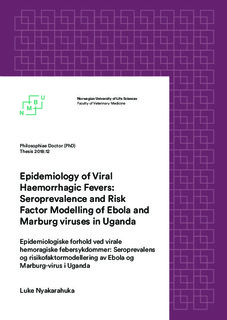| dc.description.abstract | Ebola and Marburg virus diseases, caused by Ebolavirus and Marburgvirus (filoviruses) respectively, are viral haemorrhagic fevers of public health importance. This is because of associated severity and impact on global health as it happened in Ebola Virus Disease (EVD) outbreak in West Africa in 2014 where the virus spread to other parts of the world. Uganda has reported eight filovirus outbreaks between 2000 and 2016. These outbreaks are thought to be caused by the interaction of people with animals such as non-human primates, bats and other unknown filovirus reservoirs.
In this thesis, a systematic review and meta-analysis approach was used to pool all case fatality rates (CFR), and seroprevalence of EVD and MVD reported up to the year 2015. Occurrence points for filovirus outbreaks in Uganda and selected environmental variables were used in a species distribution model using MaxEnt software to develop risk maps for filovirus outbreaks in Uganda. Further, a questionnaire was administered and focus group discussions conducted to assess risky practices, knowledge, and attitudes toward EVD and MVD outbreaks.
Blood samples were collected from apparently healthy humans and domestic animals (cattle, goat, sheep, pig and dog) from Ibanda, Kamwenge and Luweero districts in Uganda and tested for the presence IgG antibodies against ebolaviruses and Marburg virus using different serological approaches.
The weighted average CFR of EVD estimated from the meta-analysis was 65.0% (95% CI (54.0–76.0%), whereas that of MVD was 53.8% (26.5–80.0%). The overall seroprevalence of Ebola virus from published literature was estimated at 8.0% (5.0%–11.0%), whereas that for Marburg virus was 1.2% (0.5–2.0%). The most severe species of ebolaviruses was Zaire ebolavirus while Bundibugyo ebolavirus was the least severe. This review showed that EVD and MVD still present with high lethality and low prevalence and their epidemiology still needs to be elucidated.
The filovirus outbreak risk map developed predicted areas that had not reported outbreaks before, including Eastern and North-Eastern parts of Uganda. People were moderately knowledgeable about EVD and MVD, their modes of transmission and clinical symptoms; however, there is still stigma suffered by survivors and their affected families.
The overall filovirus IgG antibody seropositivity in human samples was 2.6% (19/724) of which 2.5% (18/724) was to Sudan ebolavirus, 0.1% (1/724) was to Bundibugyo ebolavirus, and 0.1% (1/724) was to Marburg virus. One individual had IgG antibody against Sudan ebolavirus and Bundibugyo ebolavirus. The risk factors for filovirus infection in humans identified included mining (OR=3.4, 95% CI; 1.3-8.5), male sex (3.1, 1.01 - 9.5), going inside mines (3.1, 1.2-8.2), cleaning corpses (3.1, 1.04-9.1) and contact with filovirus suspect cases (3.9, 1.04-14.5). This study shows that there is a possibility of Ebola and Marburg virus disease outbreaks going undetected as some people were found seropositive for filoviruses. It also shows that artisanal gold mining and living near bat-inhabited caves is a risk factor for infection with filoviruses.
From the sampled domestic animal species, goats, pigs, dogs, and sheep from Uganda and goats from Democratic Republic Congo (DRC) and Ivory Coast had detectable IgG antibodies against ebolaviruses. Presence of detectable IgG antibodies against ebolaviruses in domestic animals (goats, pigs, dogs, and sheep) shows a potential of domestic species acting as intermediate transmitters between a filovirus wildlife reservoir and human beings.
It is recommended that increased funding to do more research on filoviruses and other related emerging and re-emerging diseases, in general, to understand the epidemiology of these diseases better hence develop effective control and prevention strategies to avert future epidemics. | nb_NO |
| dc.description.abstract | Ebolavirus (EV) og Marburgvirus (MV) er virus innen filovirusfamilien og forsaker alvorlige infeksjoner med hemoragisk feber, Ebolavirussykdom (EVS) og Marburgvirussjukdom (MVS). Sjukdommene store betydning med stor dødelig og en dramatisk påvirkning av global helse ble illustrert under Ebola-utbruddet i Vest-Afrika i 2014 hvor viruset også ble spredt til mange andre deler av verden. Uganda er ett av de landene som har hatt mange utbrudd, med åtte rapporterte filovirusutbrudd mellom 2000 og 2016. Disse utbruddene antas å skyldes
samspillet mellom mennesker og dyr som primater, flaggermus og andre ukjente reservoarer av EV og MV.
I denne doktorgraden ble det brukt en systematisk litteraturgjennomgang og en statistisk metaanalyse for å vurdere dødeligheten av EVS og MVS og prevalensen av antistoff mot EV og MV, basert på studier publisert fram til 2015. Forekomst av EVS og MVS i Uganda og utvalgte miljøvariable ble så brukt i en artsdistribusjonsmodell ved hjelp av dataprogrammet MaxEnt for å utvikle risikokart for filovirusutbrudd i Uganda. Videre ble spørreskjema og fokusgruppediskusjoner benyttet i endemisk områder for å vurdere hvordan risikofylt praksis, kunnskap og holdninger påvirkes av utbrudd av EVS og MVS. Blodprøver ble samlet fra tilsynelatende friske mennesker og husdyr (storfe, geit, sau, gris og hund) fra Ibanda, Kamwenge og Luweero-distriktene i Uganda og testet for IgG-antistoffer mot EV og MV ved hjelp av forskjellige serologiske teknikker. | nb_NO |

